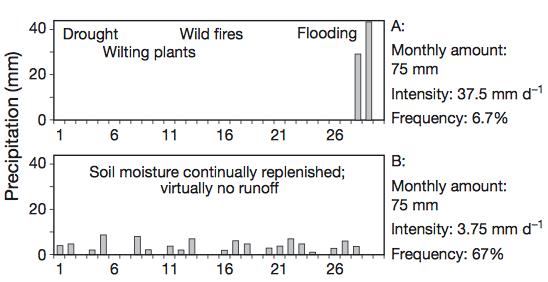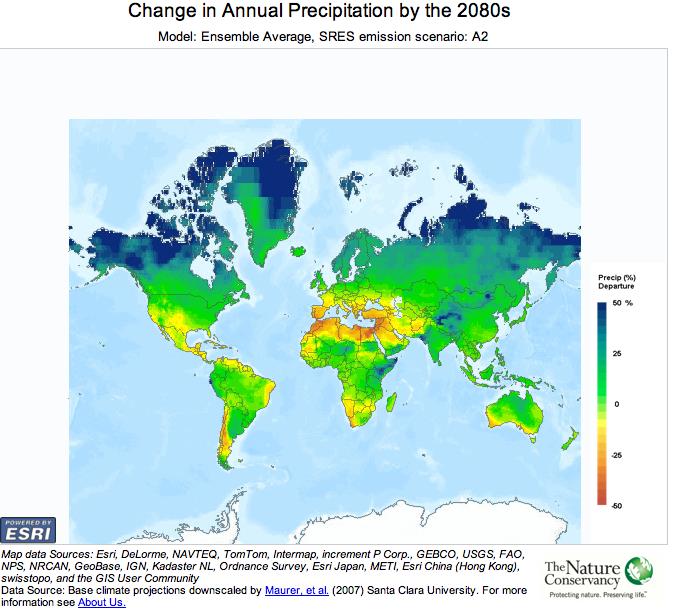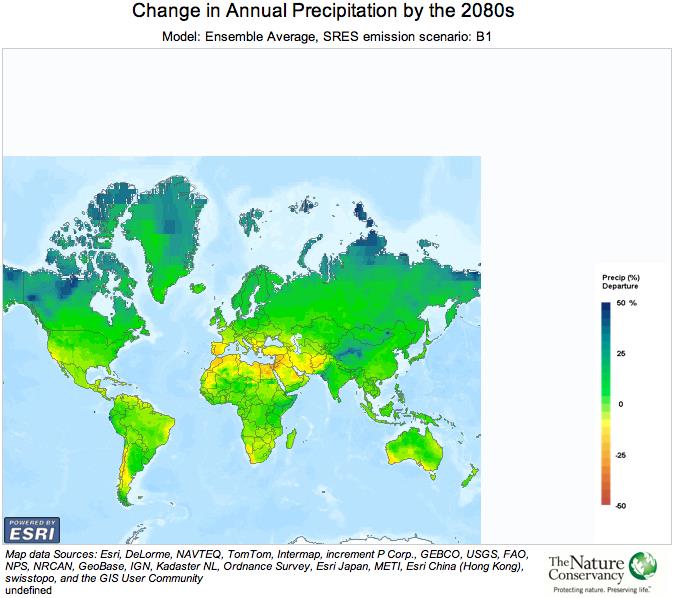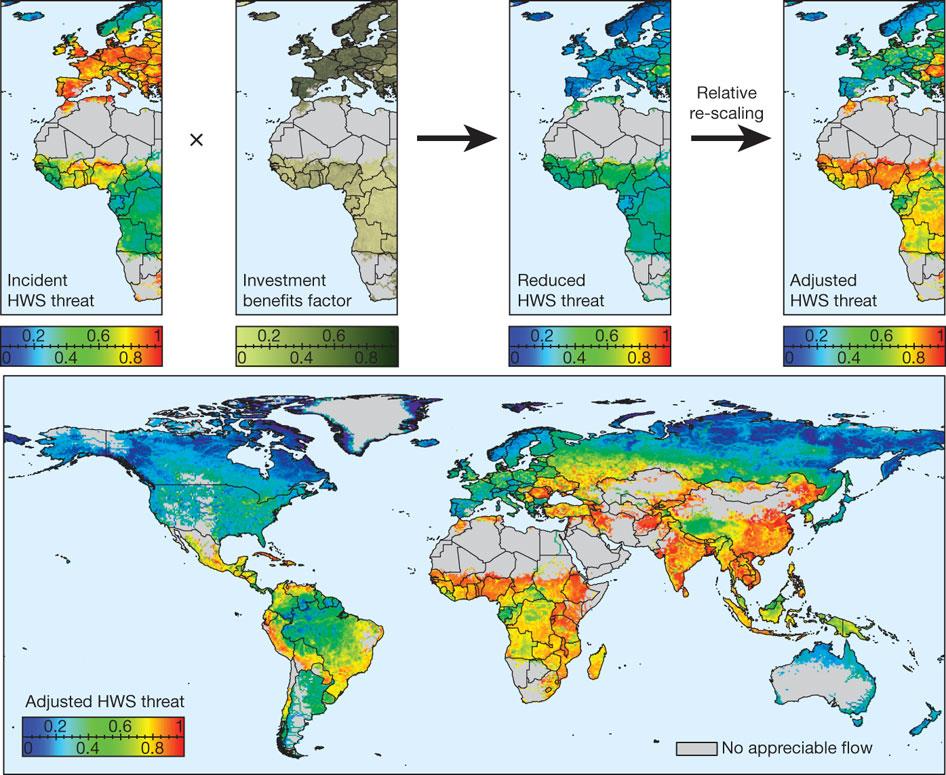Background
Climate change poses a major threat to long-term global water security. The World Bank predicts that in the 21st century, global precipitation will rise 2 percent while intensity of precipitation will rise 7 percent [1]. Higher precipitation does not mean improved water security, however, because a greater proportion of precipitation will be derived from storm events than before.

Figure 1: Comparison of storms and regular precipitation [2]
The difference between storm events and regular precipitation is illustrated in figure 1. This figure includes two scenarios, A and B, and depicts precipitation in mm versus days of the studied month. Scenario A depicts a storm event, in which precipitation is irregular. In this scenario, a drought leads to severe conditions, such as loss of biomass and wildfires. The drought is followed by a storm event, in which the landscape is flooded. The rain comes from brief, intense bursts that mostly run off of the dry ground, increasing soil erosion [2]. In scenario B, rain falls more regularly and soil maintains more consistent moisture [2]. Higher temperatures also increase transpiration rates, which increase frequency and severity of droughts [1]. Soil erosion decreases water quality, while droughts decrease water availability. In addition, it is predicted that areas with high precipitation, especially those at high altitudes, will see increases in precipitation, while dry areas will see decreases in precipitation [2].
Figure 2: Model: Ensemble Average of a scenario in which CO2 concentration in the atmosphere reaches 799 parts per million, consistent with current trends of carbon emissions [3][4]
Figure 2, a graph of predicted change in precipitation over the next 70 years, is the average of several climate models. While much of the world appears to receive more precipitation, several areas, including southern Australia, South Africa, and the entire Mediterranean region witness a dramatic reduction in precipitation levels.
In contrast, Figure 3 takes the same combination of models but with lower CO2 emission predictions:
Figure 3: Model: Ensemble Average of a scenario in which CO2 concentration in the atmosphere reaches 559 parts per million, which would require significant reduction in current emissions [3][4]
In figure 3, although roughly the same regions suffer a decrease in precipitation, this decrease is much less. Lowering CO2 concentration by 30%, then, could reduce these changes significantly.
Figures 2 and 3 show predicted trends in precipitation based on different models of CO2 concentration by 2080. Higher atmospheric CO2 concentrations correspond to greater change in precipitation. It is important to compare how these predicted trends in precipitation levels relate to current areas of high and low water security. Figure 4, a map of water security for the present day, incorporates investments countries have put into infrastructure such as dams, pipelines, and purification. For example, central Africa has abundant surface water flow but does not have the infrastructure to provide clean fresh water. In contrast, much of Europe does not have naturally secure water resources, but it does have infrastructure to provide secure water resources. Comparing this map to the precipitation predictions, Southern Europe relies on infrastructure to make the most of a very limited supply of water, which could be further threatened by decreased water availability. Also, most of northern Africa and the Middle East have already poor water resources and insufficient infrastructure, and these places will also see a decrease in total precipitation according to figures 3 and 4.
Figure 4: World map, color coded by threat to Human Water Security (HWS) [5]
Therefore, in order to address future water supply, we must address one of the root causes of climate change: increased atmospheric CO2 levels from burning fossil fuels and other industrial inputs, and find ways of reducing the amount of released CO2. This effort cannot singlehandedly solve or even reduce the water crisis. Instead, a reduction in CO2 emissions will prevent the water crisis from getting worse. Not taking action to reduce carbon emissions will inevitably worsen the water crisis, especially in the Middle East and Northern Africa.
Solution: Carbon Capture
There are two categories of carbon capture: at the immediate source of CO2 output and direct extraction from the atmosphere. Carbon capture is most efficient at high CO2 concentrations, namely at an industrial source. To actually reduce the concentration of atmospheric CO2, as opposed to slowing its growth, it can be directly removed from the atmosphere, though this is more expensive, currently costing $600 per tonne of CO2. Cost for CO2 capture from coal power plants are around $50 to $70 per tonne of CO2, so these are effective targets for CO2 capture [6].
The first step in carbon capture is to react the gas mixture with an absorbent that selectively binds CO2. This is most effective when there is a high concentration of CO2, which is why source capture of gas released from power plants is a good target for CO2 capture. The absorbent substance can be in aqueous solution, a sprayed mist, or an absorbent solid. Next, changing the conditions of the reaction chamber releases the CO2. For example, some solid absorbents will bind with CO2 under high pressure and release it when the pressure is reduced [7]. A limiting factor in the implementation of CO2 capture is the energy cost of capture methods. Absorbents typically need to be pressurized or heated to capture the CO2, then depressurized or cooled for it to be released. All of these steps require energy, which makes the process less attractive for power plants. Research should focus on reducing energy lost in this process, for example by developing more efficient absorbents that require less pressurization [6]. As of 2009, CO2 capture decreased efficiency in coal plants by around 25% and in natural gas plants by about 15 percent [8].
The other method of CO2 capture decreases the total amount of atmospheric CO2 via direct removal from the atmosphere. This has the additional benefit of being independent of energy production and has a net effect of reducing the amount of carbon dioxide in the atmosphere. Linking biofuels with carbon capture can lead to a net reduction in atmospheric CO2, as the plants take up carbon dioxide, which is then stored [9]. New power plants that run on fossil fuels or biofuels should be combined with carbon capture systems.
It is impossible for one country to control another country’s CO2 emissions, but at the same time CO2 emissions are a global issue and impact all countries. Governments do have an economic incentive to invest in carbon-removing techniques because of the significant cost of high levels of atmospheric CO2 in the atmosphere. Current CO2 levels are around 400 ppm, and the IPCC projects different scenarios. Optimistically, levels could rise to 475 ppm, less optimistically, they could increase to nearly 799 ppm by 2100 [3, 10]. According to this estimate, that difference corresponds to around 5 percent of global wealth lost to climate change, which is on the same order of magnitude as several years of recession [9].
The next stage in carbon sequestration is transporting the captured CO2 to sinks such as geological formations where it can be stored indefinitely. The CO2 can be transported through a system of pipelines. Such infrastructure already exists in a few test locations in the United States and Norway, and is feasible to implement [11]. Finally, the CO2 must be sequestered so that it does not leak back into the atmosphere or into a water supply. Since it is a non-reactive gas, it can be stored in places like saline aquifers as well as depleted oil and gas fields [12]. One challenge of CO2 storage is identifying stable storage formations. However, the global capacity for CO2 storage is estimated to be in the range of 1015 to 1016 kg, while currently about 1011 kg per year is being utilized, so storage space is not a limiting factor [13]. Also, there are restrictions transporting CO2 across certain international borders, especially if it is contaminated or pressurized [14]. CO2 can be injected into oil fields as an enhanced oil recovery method, though this process requires large quantities of water, 93 gallons of water per million BTU [15]. It does, however, provide an important incentive to collect CO2, and companies have the potential to form mutually helpful relationships. For example, in Canada an oil company sources CO2 from a synthetic fuels plant in North Dakota, transports it 205 miles by pipeline, and uses the CO2 to recover oil from an otherwise low-yielding field. The CO2 is then stored where the oil had been [12]. In areas with access to sufficient water, this method is practical and reduces groundwater contamination. CO2 can also be used as an alternative hydraulic fracturing fluid, cutting water costs from fracking.
Implementation
Politically, a huge advantage for implementing carbon capture is that oil companies benefit from developments in carbon capture technology, and they have money and political clout. Seven major energy companies have developed an organization, the CO2 Capture Project, that aims to continue research into CO2 capture [7]. The development of a cheaper, more efficient way to capture CO2 would benefit energy companies. They could continue to burn fossil fuels while reducing environmental impact. Government caps and taxes on emissions should be implemented, as these provide economic incentives for companies to reduce carbon emissions. The incentive is especially strong when governments place strict limits on CO2 emissions per megawatt hour. The United Kingdom’s limits are low enough that new coal plants must include some carbon capturing technology so as to not exceed the CO2 requirement. Norway successfully implemented a tax on carbon emissions that caused an oil company, Statoil, to begin CO2 capture and injection [16].
Initially, demonstration plants that utilize carbon capture at industrial levels showcase the feasibility of this new technology. These can be in industrialized nations with heavy energy use like the United States. When carbon capture is shown to be effective, it is less of a risk for developing countries to adopt it. The most developed and efficient carbon capture techniques are on-site CO2 removal from power plants. The US and other major greenhouse gas emitters such as China, India, and Russia should be spending billions annually on research and development for CO2 capture plants during the next decade. In comparison, the cost of a 30% increase of carbon in the atmosphere would be equivalent to approximately 5 percent reduction in global wealth from problems like decreased agricultural production [3]. Five percent of the United State’s tax revenue is closer to $115 billion [17]. In this case, it would be logical for the government to invest in research and development of carbon capture technology since it will save money in the long run, in addition to reducing the chances of an environmental catastrophe for the entire planet. Mission 2017 recommends that by 2020, no new fossil fuel plants are built without some level of CO2 removal, and by 2030 even preexisting plants should be fitted with CO2 capture technology. Combining this with direct air capture and biofuels combustion with carbon capture, by 2050, the rate of CO2 capture should exceed the rate of CO2 emissions [16]. This implementation requires additional investment in atmospheric carbon capture, which is a weaker technology than point-source capture, but is necessary for a net reduction in CO2 levels. International cooperation is necessary to convince governments of the urgency of the situation and convince them to follow Norway’s lead.
Conclusion
Climate change poses a serious threat to long-term water security, and carbon-reducing methods should be aggressively pursued by governments and private companies for their own advantage. Carbon capture is an implementable method to reduce atmospheric CO2 and it has substantial promise. CO2 capture and its urgent adoption is necessary for the sake of maintaining long-term water supply.
References
1. Alavian, V., Qaddumi, H., Dickson, E., Diez, S., Danileno, A., Hirji, R., … Blankespoor, B.(2009). Water and climate change: understanding the risks and making climate-smart investment decisions. Retrieved from http://documents.worldbank.org/curated/en/2009/11/11717870/water-climate-change- understanding-risks-making-climate-smart-investment-decisions
2. Trenberth, K. (2011 March 31). Changes in precipitation with climate change. Retrieved from http://www.int-res.com/articles/cr_oa/c047p123.pdf
3. Nakicenovi, N., Alcamo, J., Davis, G., de Vries, B., … Dadi, Z. (2013). IPCC Special reports on climate change. Retrieved from http://www.nature.com/nature/journal/v467/n7315/full/nature09440.html
4. Girvetz, E., Zganjar, C., Raber, G., Maurer, E., Kareiva, P., & Lawler, J. (2009 December). Applied Climate-Change Analysis: The Climate Wizard Tool. Retrieved from http://www.climatewizard.org
5. Vorosmarty, C., McIntyre, P., Gessner, M., Dudgeon, D., Prusevich, A., Green, P., … Davies, P. (2010 September 30). Global threats to human water security and river biodiversity. Retrieved from http://www.nature.com/nature/journal/v467/n7315/full/nature09440.html
6. Deutch, J., & Moniz, E. (2009). The MIT Energy Initiative’s Symposium on The Retrofitting of Coal-Fired Power Plants for CO2 Emissions Reductions. Retrieved from http://mitei.mit.edu/system/files/meeting-report.pdf
7. CO2 capture project. (2008). Three basic methods to separate gases. Retrieved from http://www.co2captureproject.org/pdfs/3_basic_methods_gas_separation.pdf
8. Finkenrath, M. (2011). Cost and performance of carbon dioxide capture from power generation. Retrieved from http://www.iea.org/publications/freepublications/publication/costperf_ccs_powergen.pdf
9. Keith, D., Ha-Duong, M., & Stolaroff, J. (2005). Climate strategy with CO2 capture from the air. Retrieved from http://step.berkeley.edu/Journal_Club/paper3_02092010.pdf
10. Intergovernmental panel on climate change. (2013 June). Carbon Dioxide: Projected emissions and concentrations. Retrieved from http://www.ipcc-data.org/observ/ddc_co2.html
11. U.S. Department of Energy. (2006 December). Energy Demands on Water Resources. Retrieved from http://www.sandia.gov/energy-water/docs/121-RptToCongress-EWwEIAcomments-FINAL.pdf
12. National Energy Technology Laboratory. (2010 March). Carbon Dioxide Enhanced Oil Recovery. Retrieved from http://www.netl.doe.gov/technologies/oilgas/publications/EP/CO2_EOR_Primer.pdf
13. Herzog, H. & Golomb, D. (2004). Carbon Capture and storage from Fossil Fuel Use. Retrieved from http://sequestration.mit.edu/pdf/enclyclopedia_of_energy_article.pdf
14. Hunt, P. (2010 April 27). CO2 pipeline Infrastructure: An analysis of global challenges and opportunities. Retrieved from http://www.ccsassociation.org.uk/docs/2010/IEA%20Pipeline%20final%20report%2027 0410.pdf
15. Mielke, E., Anadon, L., & Narayanamurti, V. (2010 October). Water Consumption of Energy Resource Extraction, Processing, and Conversion. Retrieved from http://belfercenter.ksg.harvard.edu/files/ETIP-DP-2010-15-final-4.pdf
16. Levina, E., Bennet, S., & McCoy, S. (2013). Technology Roadmap: Carbon capture and storage. Retrieved from http://www.iea.org/publications/freepublications/publication/name,39359,en.html
17. Schwabish, J., & Griffith, C. (2012). Budget Infographic – Revenues. Retrieved from http://www.cbo.gov/publication/43153



